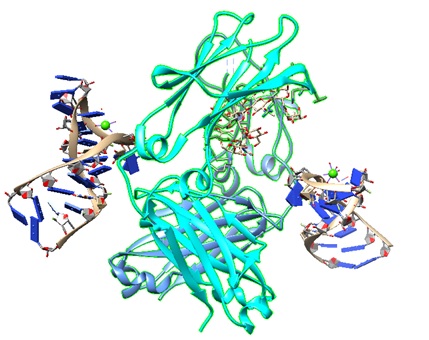Aptamers are nucleic acid-based molecules that have gained significant attention in biotechnology, medicine, and diagnostics due to their unique properties and versatile applications. These molecules are often referred to as "chemical antibodies" or "synthetic receptors" because, like antibodies, they can bind specifically to target molecules, but unlike antibodies, they are entirely synthetic.
Specifically designed aptamers allow targeting a wide range of molecular targets, including proteins, small molecules, and even whole cells.
Structure of Aptamers
Aptamers are typically single-stranded DNA or RNA molecules that fold into specific three-dimensional structures. Their unique shapes allow aptamers to recognize and bind to their target molecules with high affinity and specificity. The process of selecting or synthesizing aptamers is known as the Systematic Evolution of Ligands by Exponential Enrichment (SELEX). During SELEX, a library of random sequences is subjected to multiple rounds of selection, amplification, and purification, enriching sequences that bind to the target of interest.

Applications of Aptamers
Aptamers have a wide range of applications across various fields:
Biomedical Research: Aptamers allow the study of protein-protein interactions, elucidating the functions of specific biomolecules, and serve as tools for developing diagnostic assays and imaging agents.
Therapeutics: Aptamers have shown promise as therapeutic agents. Some aptamers, such as Pegaptanib (Macugen), have been approved for clinical use as anti-vascular endothelial growth factor (VEGF) drugs for treating age-related macular degeneration.
Diagnostic Tools: Aptamers are valuable components of diagnostic assays, for example, to enable the detection of specific biomarkers, pathogens, or toxins in clinical samples. Aptamer-based assays are often highly sensitive and specific.
Drug Delivery: Aptamers can be conjugated to drug molecules or nanoparticles, allowing targeted drug delivery. The attachment of an aptamer that binds to a receptor on a specific cell type enables more selective delivery of drugs, reducing off-target effects.
Environmental Monitoring: Well-designed aptamers can also recognize environmental pollutants or toxins. Aptamers have been used in biosensors to detect soil, water, and air contaminants.
Food Safety: Aptamers allow the detection of pathogens or harmful substances in food products, ensuring food safety.
Nanotechnology: Various applications, including drug delivery, imaging, and sensing, utilize aptamers incorporated into nanomaterials.
Advantages of Aptamers
Aptamers offer several advantages over traditional antibodies and other recognition molecules:
Ease of Synthesis: Aptamers can be synthesized in vitro, making them more readily available and cost-effective than antibodies, which often require animal immunization.
High Affinity and Specificity: Specifically designed aptamers bind their targets with high affinity and specificity, rivaling or surpassing the performance of antibodies.
Stability: Aptamers are stable under various environmental conditions, making them suitable for multiple applications.
Reproducibility: Aptamer synthesis is highly reproducible, ensuring consistent performance in assays and applications.
In summary, aptamers represent a versatile class of nucleic acid-based molecules with numerous applications in research, diagnostics, therapeutics, and beyond. The ability of aptamers to bind specific targets with high affinity and specificity, coupled with their ease of synthesis and adaptability, positions them as valuable tools in biological science, medicine, and technology.
Reference
Published examples of aptamers synthesized by BSI:
(1) Aller Pellitero M, Kundu N, Sczepanski J, Arroyo-Currás N. Os(II/III) complex supports pH-insensitive electrochemical DNA-based sensing with superior operational stability than the benchmark methylene blue reporter. Analyst. 2023 Feb 13;148(4):806-813. [PMC]
Design of electrochemical, aptamer-based (E-AB) sensors representing a specific type of E-DNA sensors that enable the continuous and real-time monitoring of molecular targets.
(2) Zhao N, Bagaria HG, Wong MS, Zu Y. A nanocomplex that is both tumor cell-selective and cancer gene-specific for anaplastic large cell lymphoma. J Nanobiotechnology. 2011 Jan 31;9:2. doi: 10.1186/1477-3155-9-2. [PMC]
Design of a functional RNA nanocomplex as a therapeutic agent as a carrier for the selective delivery of cargo to tissues and cells.
The nanocomplexes include:
a) incorporated siRNAs into a nano-sized carrier that increase their physical size and prevent the rapid elimination of siRNA from the blood circulation in vivo;
b) incorporated CD30 aptamers enabling specific accumulation of the nanocomplexes within tumor sites and eliminate potential off target side effects of the nanocomplex components; and
c) it a potential incorporation of more than one siRNA and/or therapeutic drug into the nanocomplex to generate additive or synergistic repressive effects on tumor cells.
(3) Zhao N, You J, Zeng Z, Li C, Zu Y. An ultra pH-sensitive and aptamer-equipped nanoscale drug-delivery system for selective killing of tumor cells. Small. 2013 Oct 25;9(20):3477-84. [PMC]
Design of a selective chemotherapeutic using a hollow gold nanosphere (HAuNS) equipped with a biomarker-specific aptamer (Apt), and loaded with the chemotherapy drug doxorubicin (DOX).
“The 39-mer RNA aptamer specific for CD30, a lymphoma biomarker for diagnosis of Hodgkin’s lymphoma and anaplastic large cell lymphoma, was synthesized by Bio-Synthesis (Lewisville, TX), as previously described, by using the sequence:
5′-mGmAmUUCGUAUGGGUGGGAUCGGGAAGGGCUACGAACAmCmCmG-[Thiol]-3′
(mN represents 2′-O-Methyl RNA).”
(4) Zhang P, Zhao N, Zeng Z, Feng Y, Tung CH, Chang CC, Zu Y. Using an RNA aptamer probe for flow cytometry detection of CD30-expressing lymphoma cells. Lab Invest. 2009 Dec;89(12):1423-32. [PMC]
Design and synthesis of a 39-mer nucleotide RNA aptamer with one minor modification: 5′-gauUCGUAUGGGUGGGAUCGGGAAGGGCUACGAACAccg-3′. The aptamer probe contains the most essential functional motif with the highest affinity to mouse CD30 molecules in solution. To enhance its resistance to nucleases, the first three nucleotides on each end of the aptamer were synthesized with 2′-O-methyl modification (indicated by lower case letters).
(5) Cheng S, Jacobson O, Zhu G, Chen Z, Liang SH, Tian R, Yang Z, Niu G, Zhu X, Chen X. PET imaging of EGFR expression using an 18F-labeled RNA aptamer. Eur J Nucl Med Mol Imaging. 2019 Apr;46(4):948-956. [PMC]
Design and production of a biolayer interferometry binding assay using an alkyne modified EGFR aptamer MinE07 (ME07). The use of 18F-Fluorobenzoyl (FB) azide allowed labeling the aptamer for its use in positron emission tomography (PET) scans of tumor models.
Others
Wang, A. Z., and O. C. Farokhzad. "Current Progress of Aptamer-Based Molecular Imaging." 2014.
https://doi.org/10.17615/bd33-km50.
Kubiczek, C., et al. "Aptamers As Promising Agents in Diagnostic and Therapeutic Applications." 2017.
https://core.ac.uk/download/210975297.pdf.
Publications - Salk Institute for Biological Studies.
https://www.salk.edu/scientist/gerald-joyce/publications/
BSI links to aptamers
https://www.biosyn.com/aptamers.aspx Website
Custom Aptamers
https://www.biosyn.com/tew/Custom-Aptamer-Synthesis.aspx
Specifically labeled oligonucleotides
https://www.biosyn.com/tew/Specific-labeling-of-RNA.aspx#!
---...---